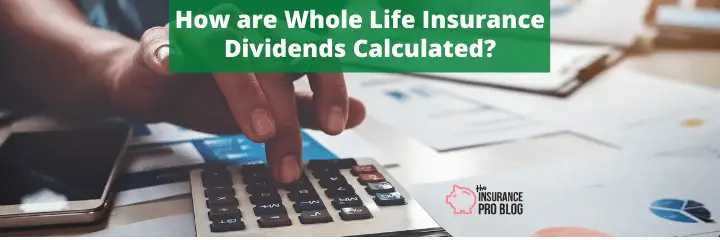Reversing the process for calculating the payable dividend on a whole life insurance policy is nearly impossible given the proprietary nature of life insurers. This said we can use several pieces of information to at least create an approximation on the correctness of the dividend earned on a whole life policy in any given policy year.
The quickest and easiest way to do this is using the life insurance illustration. The ledgers found inside the illustration normally project the payable dividend in all policy years, we can simply use this to reconcile the dividend earned in a specific policy year.
But…
The dividend can change, and if it does the original illustration is no longer accurate. Now what do we do?
We simply request an in-force illustration that uses the newly declared dividend rate and use this moving forward to reference the dividend earned. We'll need to do this every time the dividend changes at the insurance company.
The other way to do this is far more complicated and before we dive into the process of taking on this approach, let's spend some time understanding the components of the dividend and the information we'll have (at least some) access to that will allow us to attempt reverse engineering the dividend calculation. Word of caution, this process is not for the faint of heart and the above-mentioned process will ALWAYS be the easier way to approach this question.
What is a Dividend on a Whole Life Policy?
A dividend paid on a whole life policy is the mechanism life insurers use to share the profitability of their business operations with policyholders. This teases an obvious question.
Why would life insurers want to share their profits with policyholders?
Several don't. And they generally do not.
But, some life insurers in the United States operate as mutual life insurance companies (or pseudo mutual life insurers, which is a subject for another day). These insurers place the ownership of the company in the hands of the people who buy insurance policies from the company. These types of life insurance companies have a legal imperative to produce profits for their owners (i.e. the policyholders) and they do this through the payment of dividends.
Technically speaking, dividends officially operate as a refund of premiums paid by the policy owner. This is a unique tax classification that gives life insurers and life insurance policy owners a significant tax break/advantage.
The Three Components of a Life Insurance Dividend
Whole life insurance dividends draw from three sources:
- Underwriting Profits
- Investment Returns
- Administrative Costs
Underwriting profits come from the profitability of being an insurance company. This happens most commonly when fewer people file claims (i.e. die) than the insurance company expected. Predicting death rates among a large group of people is surprisingly easy, so life insurers rarely lose  money on this variable.
money on this variable.
Investment returns drive the cash value accumulation component of a life insurance contract. Insurers seek to generate investment income at least sufficient to cover the guaranteed provisions of the contract. The majority of life insurers successfully generate investment income well in excess of guaranteed contract features. Income created in excess of these contractual obligations is profit that feed into the dividend payment. This variable generally plays the biggest role in the overall dividend payment and it's the focus of the often talked about dividend interest rate.
Administrative costs are the boring day-to-day expenses the life insurer faces that compare to common expenses any business faces. This includes things like office supplies, rent on office space, utility bills, wages, etc. When the life insurers operates under budget for these expenses, that surplus can go towards the dividend payment.
The Whole Life Insurance Dividend Interest Rate
Many insurance companies that issue whole life insurance announce the dividend interest rate when they announce the dividend payment for the year. While many people assume they understand what the dividend interest rate tells them, the truth is very few people truly understand what this data point conveys.
The dividend interest rate simply tells us the input value the insurer is using when it calculates the actual dividend payable on a whole life insurance policy. It's one variable of…at least…three (see above for the other two).
Further complicating matters concerning the dividend interest rate, there is no standardized protocol for arriving at and publicly announcing a dividend interest rate. So what assumptions one company might make that cause them to declare a 6.95% dividend interest rate could vary considerably from the assumptions another company makes that cause it to declare a 7.05% dividend interest rate. For this reason, it's highly inaccurate to assume that you can compare the nominal rates declared by each insurance company to quickly assess who pays the higher dividend. The matter is far more complicated.
So the dividend interest rate simply tells us the number that the insurer will plug into a much larger equation to calculate a policy owner's dividend for the year. But there is something else the number is telling us.
The dividend interest rate does give us a sense of how much value the insurer returns to each policyholder beyond the guaranteed features of the contract. Dividend interest rates include the guaranteed accumulation rate of the policy, which today sits somewhere between 3.5 and 4%. So a 6% dividend interest rate implies that the insurer's dividends payable by investment income generated by the assets held by the insurer are 200 basis points above the guaranteed accumulation rate–assuming the whole life contract has a 4% guaranteed accumulation rate.
We can use this knowledge to do some reverse engineering to the payable dividend.
Using the Dividend Interest Rate to Get a Sense of the Payable Dividend
Assuming a 6% dividend interest rate and a 4% guaranteed accumulation rate leaves us with 2% as the variable we'll use to check on the dividend paid by the life insurer. This 2% is paid on the reserve of the policy, which is a complex subject but is usually very similar to the accumulation value of the contract.
 If we take the current cash value of the policy and multiply it by 2%, we'll arrive at a number that will be very similar to the payable dividend on the policy. There will almost certainly be some variance, and this is driven by three major factors:
If we take the current cash value of the policy and multiply it by 2%, we'll arrive at a number that will be very similar to the payable dividend on the policy. There will almost certainly be some variance, and this is driven by three major factors:
First, the adjustments made by the other major variable mentioned above (e.g. underwriting profits and administrative costs) are not part of this calculation. The larger these variables impact the payable dividend, the less accurate this calculation will be.
Second, the reserve is not identical to the cash surrender value, so this may cause the payable dividend to differ from the results we get from this calculation.
Third, somewhat tied to the first factor and usually only at play in the very early and very late years of a policy, various expense assumptions may play a significant role in adjusting the dividend. For example, most life insurers use an expense assumption on whole life policies known within the industry as a modified reserving system. This effectively treats whole life policies like they are term life policies for the first year or two of a whole life's existence. This dramatically reduces the reserve requirements an insurer must meet with a whole life policy, and it's the primary explanation behind why many regular whole life policies pay no dividends to the policy owner for the first couple of policy years.
So while this approach to analyzing the dividend will never have great precision insofar as it will never work out perfectly and certainly now allow us to reconcile the insurance company's math. It will allow us to infer a few things about a whole life policy.
If the product of this calculation is a number greater than the payable dividend we know the insurer either had higher expenses under the other two variables that caused a negative adjustment to the dividend or some other costing allowance is at play that permits the insurer to take a loss on the policy in this policy year.
If the product of this calculation is a number less than the payable dividend we know that the other variables at play (underwriting profits and/or administrative expenses) potentially increased the overall dividend and/or the reserve is larger than the cash value of the policy.

